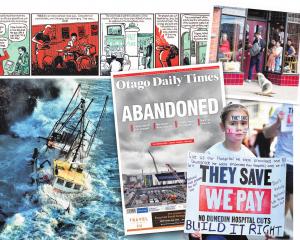Dunedin landowners whose property is in one of the 2GP's hazard zones need not fear the cold shoulder, the insurance industry says.
Thousands of Dunedin properties fall into the new hazard zones included in the 2GP.
Most of the Flat and the Taieri Plain are flood zones, while parts of Otago Peninsula, Saddle Hill and vast areas north of Blueskin Bay are land instability zones.
But having those hazards included in the new district plan was unlikely to have any great effect on the cost or availability of insurance for the land's owners, Insurance Australia Group Ltd (IAG) spokesman Craig Dowling said.
''At this particular point in time, nothing has changed from our perspective in terms of information we have as an insurer from which we then determine premiums.''
In fact IAG, which owns several New Zealand insurance brands including State, AMI and NZI, believed the increased awareness of risks was ''a good thing for homeowners and communities''.
That awareness should lead to community and local and central government action ''to plan for and mitigate impact of damage caused by the identified risks''.
Given the ''general principle'' that premiums were influenced by ''increased claims costs over time, along with other information'', the company believed ''such interventions can have positive benefits'', Mr Dowling said.
Those benefits could include ''resilient, stronger and safer communities, which then tend to be communities with good access to affordable insurance'', he said.
Tim Grafton, chief executive of the Insurance Council of New Zealand (ICNZ), said the new hazard designations were not likely to have any great effect on property owners' insurance.
Insurers were in the business of knowing how much risk a property carried, including natural hazards such as flooding and landslips, whether a council designated them in a district plan or not.
''Insurers have ongoing awareness of natural hazards and evaluate this risk throughout the country.
''Each insurer will decide their own appetite for risk and how that will affect premiums.
''The council's proposed 2GP plan will be looked at by insurers, but it is not the only information they rely upon for assessing a property's risks to natural hazards.''
Areas with increased flooding vulnerability, sea-level rise and storm surge were of concern to insurers, ''as these place properties at risk and we urge adaptation measures be undertaken by councils to reduce risks posed by natural hazards'', he said.
But the transparency property owners gained when councils identified risks from natural hazards was a good thing, he said.
An AA Insurance spokeswoman said all insurance cover was assessed case by case where insurers considered the ''likelihood and impact of any risks to a property, including hazards''.
Insurers would gather all relevant information when they made their assessments, she said.
''As more information becomes available regarding location-based potential risks to property, it's likely insurers will begin to rate risk more specifically.''












